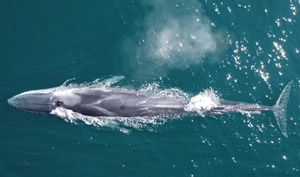 In the summer of 2023, the marine research vessel Song of the Whale conducted research off the coast of Martha’s Vineyard, focusing on fin whales. Researchers used drones to tag whales and gather material from their blowholes. The aim was to study fin whale behaviour near offshore wind energy sites under construction.
In the summer of 2023, the marine research vessel Song of the Whale conducted research off the coast of Martha’s Vineyard, focusing on fin whales. Researchers used drones to tag whales and gather material from their blowholes. The aim was to study fin whale behaviour near offshore wind energy sites under construction.
Doug Nowacek, a marine conservation technologist at Duke University, is the principal investigator of the Wildlife and Offshore Wind (WOW) project. This project, funded by the U.S. Department of Energy’s Wind Energy Technologies Office and the Bureau of Ocean Energy Management (BOEM), aims to ensure that offshore wind developments are compatible with local wildlife.
The WOW team, consisting of researchers from various institutions, aims to understand the impact of offshore wind energy on wildlife. They study species such as seabirds, bats, marine mammals, and sea turtles. The project investigates how these species respond to construction noise, changes in habitat use, and collision risks with wind energy infrastructure.
BOEM enforces noise restrictions on construction projects and mandates work stoppages when whales are spotted nearby. Construction of Vineyard Wind I and Empire Wind I, two large wind farms off the coasts of Massachusetts and New York, is expected to be completed in summer 2024.
During the first year of WOW, the team conducted assessments to shape their fieldwork. The University of St. Andrews in Scotland performed a survey and research gap analysis, while Duke University’s Marine Geospatial Ecology Lab created density maps of species to determine study areas.
In the second year, Nowacek’s team focused on tagging and monitoring fin whales. They used satellite-linked transmitters to gather data on whale behaviour. This information is crucial for understanding the impact of construction on whale acoustic habits.
Another WOW team conducted research on Muskeget Island, tagging gulls to track their movements and flight heights, which is important for assessing collision risks with wind turbines. The team also used drones to photograph whales, aiding in species tracking.
Future research will track animal behaviour during the operational phase of wind turbines. Nowacek is confident that the WOW project will provide valuable insights into the relationship between offshore wind energy development and wildlife, guiding future developments globally.








